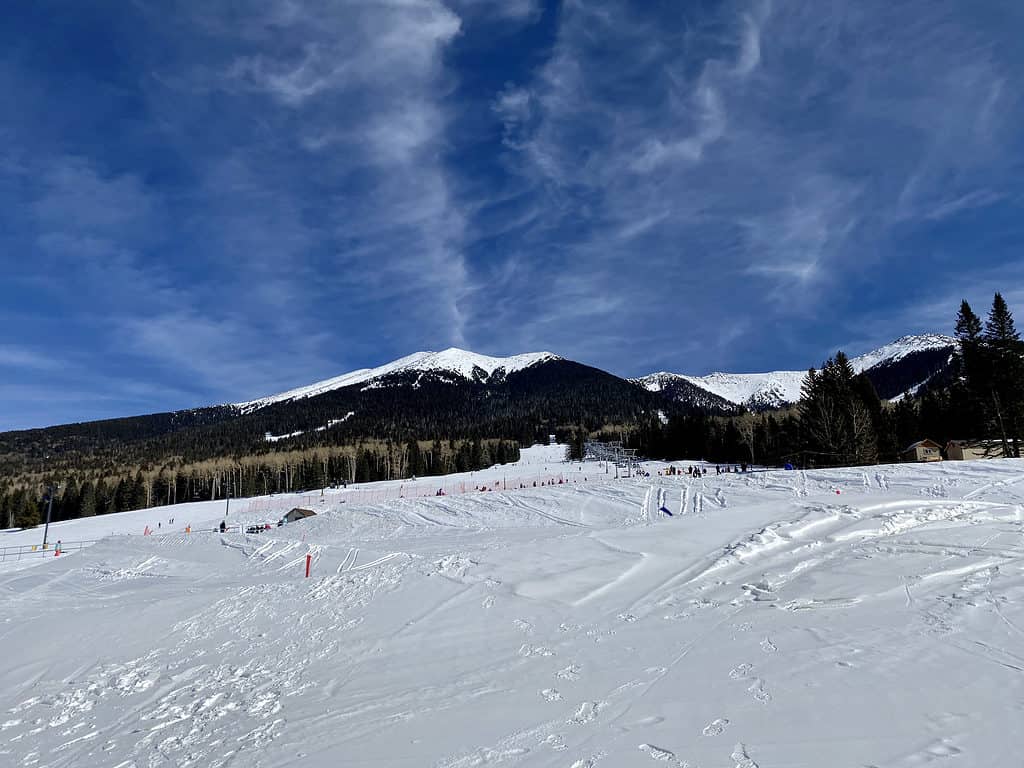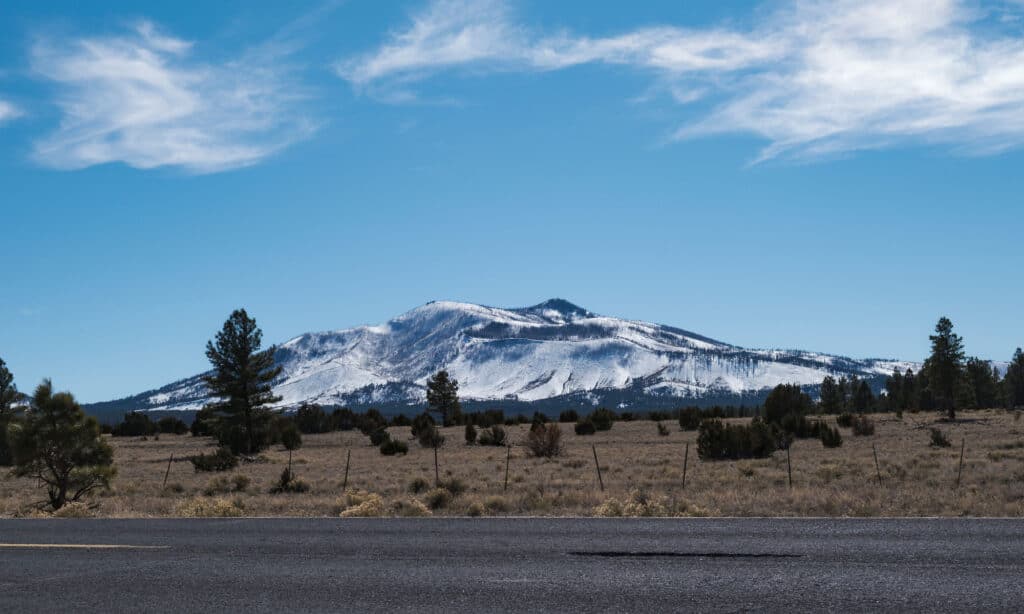The majority of Arizona sees mild average winter temperatures. However, some areas like Flagstaff, Arizona are known for snow abundance and cold temperatures during the winter season. The coldest winter ever recorded might be surprising when compared to current average temperatures. Global warming, amidst other factors, has gradually changed the winter climate in Arizona, making it warmer and more attractive for migratory animals.
Average Winter Weather and Climate in Arizona
Arizona’s climate is a combination of arid, semiarid, and humid, with a semiarid climate covering around 50% of the state. Winters in the state of Arizona are not unbearable nor do residents experience harsh temperatures. For instance, the average maximum temperature in Phoenix during the month of January measures 65ºF.
Average temperatures during winter in the northwest corner of Arizona lie between 23.6ºF and 52.4ºF. The mean January temperature for this region is 34.9ºF. On the other hand, the Flagstaff region sees much lower average temperatures than those of the northwest portion. During winter, average temperatures in the Flagstaff region range from 12.7ºF to 44.9ºF. Mean January temperatures measure 28.7ºF for the Flagstaff region.
Heading further south, average winter temperatures for the Phoenix region begin to increase. Records show average maximum temperatures at 72.3ºF and average minimums measuring 43.1ºF. The average mean temperature for January in the Phoenix region is 53.7ºF. Finally, the southeast corner of Arizona, or the Tucson region, sees an average low of 41.2ºF and average highs of 67.9ºF during winter. The mean average temperature for the month of January in the Tucson region is 51.3ºF.
Frosts can occur in some regions of Arizona during winter, but the state remains sunny and warm for most of the year. Winter is characterized by some precipitation deriving from the Pacific Ocean. Arizona typically receives little rainfall overall, though. The state averages between 10 and 15 inches of rainfall every year.
Snowfall in Arizona

The Flagstaff region of Arizona receives a maximum average of 0.6 inches of snowfall per day during winter and a mean of 0.2 inches per day.
©iStock.com/Md Esharuzzaman Emu
Snowfall in many parts of the state is rare due to minimal precipitation and high average winter temperatures. In the northwest corner of the state, no more than an average of 0.1 inches of snow falls per day during winter. The Flagstaff region receives a maximum average of 0.6 inches of snowfall per day during winter and a mean of 0.2 inches per day.
On some occasions, the Flagstaff region will receive around 39.5 inches of snowfall. Even more surprising, the city of Flagstaff itself will see over 200 inches of snowfall dumped every year. It’s clear that snowfall varies greatly within the Flagstaff region, as well as throughout the remainder of the state.
The Phoenix region receives no snowfall whatsoever during winter. Likewise, the Tucson region does not experience snowfall. Overall, Arizona is not a snowy state. Snowfall is a rarity in most of the state, due to sunny days, little precipitation, and high temperatures.
Coldest Winter Ever Recorded in Arizona
The coldest temperature ever recorded in Arizona occurred in 1971. Temperatures at Hawley Lake reached -40ºF on January 7, 1971. This record-breaking temperature was a surprise for most Arizona residents, as average winter temperatures rarely dip below the teens. Hawley Lake is a reservoir that sits in the White Mountain Apache Indian Reservation. Hawley Lake’s elevation likely contributed to the temperature drop, as it lies 8,200 feet above sea level.
While Lake Hawley recorded the lowest temperature, it was not necessarily the coldest winter recorded in the state. The Tucson and Phoenix regions experienced their coldest winters on record, with temperature minimums of 6ºF and 16ºF, respectively, between 1912 and 1913. During this period, the Flagstaff region experienced temperatures as low as -23ºF.
However, the Flagstaff region has experienced colder winters than that of 1913. In 1916, temperatures reached -25ºF in January. Likewise, the winter of 1937 saw a minimum temperature of -30ºF. Taking the entire state into consideration, 1912 to 1913 displayed the lowest temperature records for Arizona since the year 1900. Therefore, the winter of 1913 wins for the coldest winter in Arizona history.
Snow during the winter of 1912 to 1913 piled up to 65.4 inches in the Flagstaff region, with an average of 0.2 inches of snowfall per day. However, the Phoenix area saw no snow during this coldest winter, while the Tucson region received a total of 2 inches during January of 1913.
Winter in Arizona Now

Overall, the 2022-2023 winter in Arizona is nowhere near as cold as the winter recorded between 1912 and 1913.
©iStock.com/Nick Francis
In the winter spanning 2022 and 2023, the Flagstaff region has seen a minimum temperature of -5ºF during January and a temperature average of 33.3ºF during the months of November and December. By comparison, the northwest corner of the state experienced a minimum temperature of 14ºF during November and an average temperature of 39.9ºF during the last couple months of 2022.
In the south, the Phoenix region measured a minimum temperature of 35ºF in January and an average winter temperature of 57.9ºF. Likewise, the Tucson region stayed warm, with a minimum temperature reaching no less than 28ºF in January and average winter temperatures of 56ºF. Thus, there is a great disparity in temperature minimums and averages between south Arizona and north Arizona.
So far, the Tucson region and Phoenix region have seen no snowfall. The Flagstaff area, on the other hand, has experienced a grand total of 24.1 inches of snowfall this year, with daily averages measuring between 0.1 and 0.7 inches. The northwest corner of the state has little to no records of snowfall for cities within the region. Overall, though, the 2022-2023 winter in Arizona is nowhere near as cold as the winter recorded between 1912 and 1913.
Climate Change Effects on Winters in Arizona
Arizona’s temperatures have increased approximately 2ºF in the past 100 years. Snow in northern parts of Arizona has begun melting sooner as spring rolls around. Occurrences of wildfires are more frequent. Increased temperatures can lead to more rapid evaporation rates, which cause drought. Furthermore, decreased snowpack due to global warming affects tourism during winter in the state. Shockingly, temperatures have risen so substantially that migratory animals are moving to Arizona, rather than Mexico.
Animals that Migrate to Arizona in Winter
A popular migration spot for animals during winter is the Sonoran Desert region, which covers parts of Arizona, California, Mexico, and the Pacific Ocean. White-tail deer, who reside in the mountains during summer, will migrate down to the Sonoran Desert region as temperatures begin to decrease. Likewise, red-tailed hawks will fly from northern Arizona down south if winter temperatures become harsh. Geese and butterflies will also make their way to and through Arizona as fall begins to roll around.
Some of the most prevalent migrators in Arizona include hummingbirds. While calliope and costa’s hummingbirds typically fly through Arizona into Mexico for the winter, the black-chinned hummingbird is more adapted for Arizona winter temperatures. It migrates to Arizona to breed there.
In addition, birds that previously traveled through Arizona during their migration to Mexico have recently begun to stay in the state. As global temperatures begin to warm, Arizona becomes a better place for bird species to avoid the cold of winter without making the pain-staking trip across the border.
Waterfowl have recently begun spending winters in Arizona, and they appear to be staying for longer periods that in the past. Canadian geese are some of the most prevalent waterfowl to migrate to Arizona for recent winters. Apart from global warming, urbanization has also led to this influx of bird species in the state. Arizona’s man-made lakes are a popular habitat for these waterfowl.
Up Next:
Thank you for reading! Have some feedback for us? Contact the AZ Animals editorial team.








